The Wood Moisture Tester Market is estimated to be valued at USD 126.6 million in 2025 and is projected to reach USD 216.3 million by 2035, registering a compound annual growth rate (CAGR) of 5.5% over the forecast period.
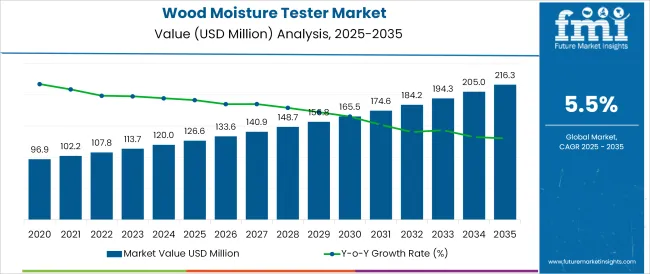
The wood moisture tester market is experiencing accelerated growth as demand for accurate and real-time moisture measurement intensifies across construction, woodworking, and forestry sectors. The increasing emphasis on quality control and structural integrity in timber based applications has elevated the need for reliable moisture assessment tools.
Technological innovation has introduced digital interfaces, Bluetooth connectivity, and data logging features that enhance user experience and enable actionable insights on-site. With regulatory agencies and industry standards mandating moisture level thresholds in wood based materials, the adoption of precision testing devices has become indispensable.
Furthermore, rising awareness around moisture-related defects such as warping, cracking and fungal growth has expanded usage across small-scale carpentry operations and large industrial processing units. As the market shifts towards ergonomic and multifunctional tools with higher durability, future opportunities are expected in sensor-integrated platforms, mobile app-based diagnostics, and cloud-synced moisture profiling, especially in regions with growing housing and infrastructure activities.
The market is segmented by Technology Type, Mobility Type, Probe Type, and End Use Industry and region. By Technology Type, the market is divided into Digital and Analog. In terms of Mobility Type, the market is classified into Portable and Benchtop. Based on Probe Type, the market is segmented into Pin, Pinless, and Combination.
By End Use Industry, the market is divided into Construction, Furniture, Paper & Pulp, and Other. Regionally, the market is classified into North America, Latin America, Western Europe, Eastern Europe, Balkan & Baltic Countries, Russia & Belarus, Central Asia, East Asia, South Asia & Pacific, and the Middle East & Africa.
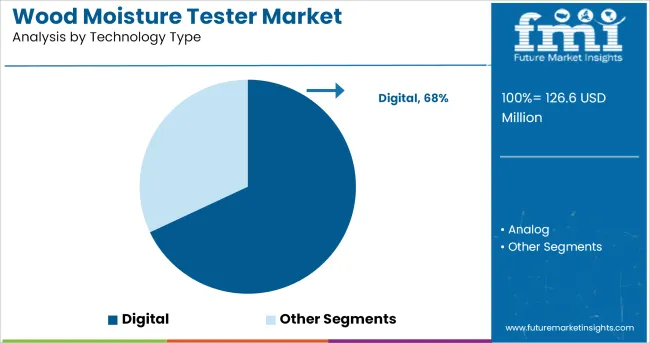
Digital wood moisture testers are expected to hold 68.0% of the total revenue share in 2025, making them the dominant technology type. This leadership is attributed to their superior accuracy, real-time data display, and user-friendly interfaces that enable fast, repeatable, and precise readings.
Digital devices often include features such as backlit screens, multiple wood species calibration, and internal memory for data storage enhancing usability across varying work conditions. Their compatibility with mobile applications and ability to integrate with project documentation tools further supports efficiency for professionals in construction and woodworking.
As industries demand increasingly traceable and quality-assured moisture data, digital testers have outpaced their analog counterparts. In addition, falling component costs and higher availability through online channels have made digital devices more accessible to a wider range of users, solidifying their market-leading position.
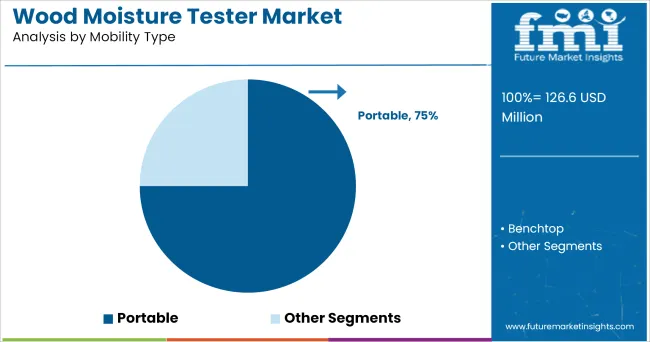
The portable category is projected to dominate the market with a 75.0% revenue share in 2025 under the mobility type segment. This dominance has been driven by the increasing demand for lightweight, handheld tools that provide moisture readings directly at worksites or production floors. Portability allows users to carry and deploy testers in a wide range of environments from remote lumber yards to residential construction sites without the constraints of fixed equipment.
Battery-operated designs, compact form factors, and ruggedized casings have further reinforced adoption among professionals requiring mobility without sacrificing measurement accuracy. Portable models also support quick inspections during procurement, installation, and final inspections, aligning with workflow efficiency needs across industries.
The preference for on-the-go tools that combine ease of use with professional-grade performance has firmly established portable testers as the preferred mobility format in the market.
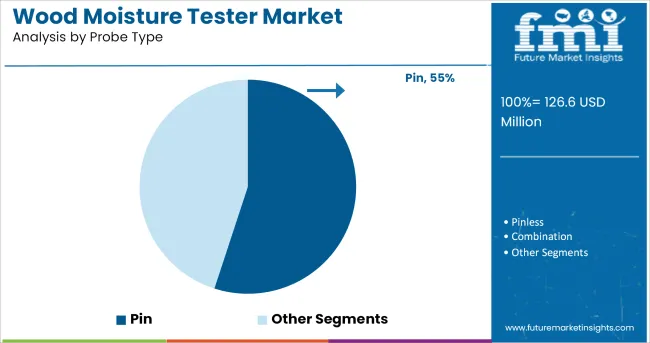
The pin probe segment is expected to account for 55.0% of total revenue in 2025 when measured by probe type, positioning it as the leading category. This segment’s dominance is linked to its proven ability to measure moisture content through direct contact with the wood's internal structure.
Pin-based testers penetrate the surface to provide accurate readings even in dense or unevenly dried wood, making them particularly valuable in quality-critical applications. The preference for pin probes is further supported by their reliability across softwoods, hardwoods, and engineered wood products.
The preference for pin probes is further supported by their reliability across softwoods, hardwoods, and engineered wood products. While pinless technology is growing in parallel, professionals often rely on pin testers for their diagnostic precision, especially in conditions requiring thorough moisture mapping. The simplicity of operation, widespread market familiarity, and compatibility with industry compliance standards have helped.
The growing demand for moisture tester for wood products, building inspection, and flooring. In the wood industry, moisture remains a key concern as high moisture content in wood can harm the durability and quality of wood products. Wood moisture tester provides nondestructive analysis of wood sample.
With wood being a preferred construction material in building panels, flooring and other structural parts at interior and exterior sites, the device utilization rate is expected to gain a notable traction during the forecast period. Also, with increasing demand for the device as wood and paper samples in pulp paper products is expected to support the market growth to a considerable extent.
Moisture tester are used to measure the moisture content of paper, textiles, wood, concrete, and other building materials. These multifunction moisture tester for wood also determines the ambient relative humidity and temperature.
Leading manufacturers of the device are focusing on introducing technologically upgraded wood moisture tester such as multifunctional display functionalities for ease of moisture analysis of the wood. Vendors of wood moisture tester are focusing on launching new wood moisture tester for moisture measurement applications such as restoration, moisture detection, lumber (wood) testing, and building inspections.
Manufacturers are also designing new prototypes with Bluetooth mode for wireless connection to Android and iOS instruments. These progress by key manufacturers of moisture tester are fuelling the growth of the wood moisture tester market during the forecast period at a substantial CAGR.
South East Asia nations consisting of India, Malaysia, and New Zealand are expected to be regional markets of promiscuous growth in the upcoming years on the backdrop of establishment production hub of engineered wood products, timber products whose consumption rates will be at healthy levels in domestic and export markets. Ensuring of ISO Certified production and quality management initiatives is anticipated to record robust sales volume of the device in the mentioned regional markets.
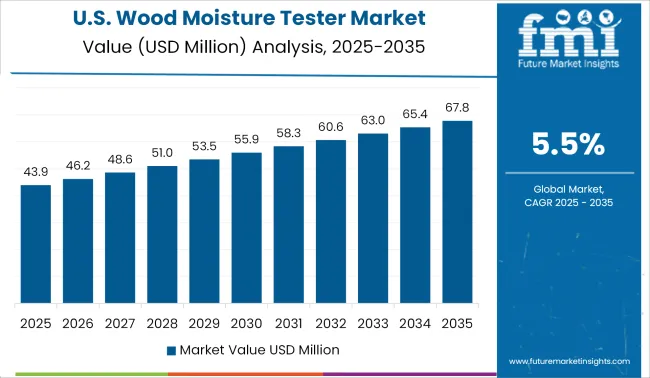
USA and Canada, are expected to witness prominent growth during the forecast period owing to the rising automation technology in the construction industry for increasing durability of wood and other flooring material. These parameters of the wood moisture tester market are expected to witness significant growth in terms of value during the forecast period globally.
With wood preferred as a primary building material for residential household units in both the countries, the demand from new vs. retrofit installations will ensure hefty procurement rate of wood moisture tester by the end users.
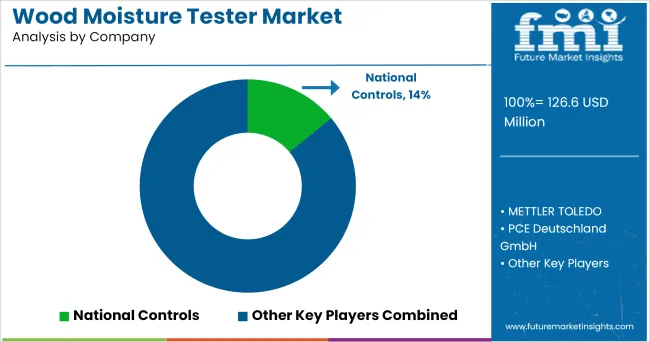
Some of the prominent players of the device include
The report is a compilation of first-hand information, qualitative and quantitative assessment by industry analysts, inputs from industry experts and industry participants across the value chain. The report provides in-depth analysis of parent market trends, macro-economic indicators and governing factors along with market attractiveness as per segments. The report also maps the qualitative impact of various market factors on market segments and geographies.
The global wood moisture tester market is estimated to be valued at USD 126.6 million in 2025.
The market size for the wood moisture tester market is projected to reach USD 216.3 million by 2035.
The wood moisture tester market is expected to grow at a 5.5% CAGR between 2025 and 2035.
The key product types in wood moisture tester market are digital and analog.
In terms of mobility type, portable segment to command 75.0% share in the wood moisture tester market in 2025.






Our Research Products

The "Full Research Suite" delivers actionable market intel, deep dives on markets or technologies, so clients act faster, cut risk, and unlock growth.

The Leaderboard benchmarks and ranks top vendors, classifying them as Established Leaders, Leading Challengers, or Disruptors & Challengers.

Locates where complements amplify value and substitutes erode it, forecasting net impact by horizon

We deliver granular, decision-grade intel: market sizing, 5-year forecasts, pricing, adoption, usage, revenue, and operational KPIs—plus competitor tracking, regulation, and value chains—across 60 countries broadly.

Spot the shifts before they hit your P&L. We track inflection points, adoption curves, pricing moves, and ecosystem plays to show where demand is heading, why it is changing, and what to do next across high-growth markets and disruptive tech

Real-time reads of user behavior. We track shifting priorities, perceptions of today’s and next-gen services, and provider experience, then pace how fast tech moves from trial to adoption, blending buyer, consumer, and channel inputs with social signals (#WhySwitch, #UX).

Partner with our analyst team to build a custom report designed around your business priorities. From analysing market trends to assessing competitors or crafting bespoke datasets, we tailor insights to your needs.
Supplier Intelligence
Discovery & Profiling
Capacity & Footprint
Performance & Risk
Compliance & Governance
Commercial Readiness
Who Supplies Whom
Scorecards & Shortlists
Playbooks & Docs
Category Intelligence
Definition & Scope
Demand & Use Cases
Cost Drivers
Market Structure
Supply Chain Map
Trade & Policy
Operating Norms
Deliverables
Buyer Intelligence
Account Basics
Spend & Scope
Procurement Model
Vendor Requirements
Terms & Policies
Entry Strategy
Pain Points & Triggers
Outputs
Pricing Analysis
Benchmarks
Trends
Should-Cost
Indexation
Landed Cost
Commercial Terms
Deliverables
Brand Analysis
Positioning & Value Prop
Share & Presence
Customer Evidence
Go-to-Market
Digital & Reputation
Compliance & Trust
KPIs & Gaps
Outputs
Full Research Suite comprises of:
Market outlook & trends analysis
Interviews & case studies
Strategic recommendations
Vendor profiles & capabilities analysis
5-year forecasts
8 regions and 60+ country-level data splits
Market segment data splits
12 months of continuous data updates
DELIVERED AS:
PDF EXCEL ONLINE
Wood Awning Window Market Size and Share Forecast Outlook 2025 to 2035
Woodcore Access Floor Market Size and Share Forecast Outlook 2025 to 2035
Woodworm Treatment Service Market Size and Share Forecast Outlook 2025 to 2035
Wood Plastic Composite Market Size and Share Forecast and Outlook 2025 to 2035
Wooden Pallet Rental Service Market Size and Share Forecast Outlook 2025 to 2035
Wood Recycling Equipment Market Size and Share Forecast Outlook 2025 to 2035
Woodfree Paper Market Size and Share Forecast Outlook 2025 to 2035
Wooden Crate Market Forecast and Outlook 2025 to 2035
Wood-Polymer Bottle Molders Market Size and Share Forecast Outlook 2025 to 2035
Woodworking CNC Tools Market Size and Share Forecast Outlook 2025 to 2035
Wood Pellets Market Size and Share Forecast Outlook 2025 to 2035
Wooden Cutlery Market Size and Share Forecast Outlook 2025 to 2035
Wood Coating Resins Market Size and Share Forecast Outlook 2025 to 2035
Wooden & Plywood Packaging Market Size and Share Forecast Outlook 2025 to 2035
Wood Adhesives and Binders Market Size and Share Forecast Outlook 2025 to 2035
Wood Adhesives Market Size and Share Forecast Outlook 2025 to 2035
Wooden Furniture Market Size and Share Forecast Outlook 2025 to 2035
Woody Biomass Boiler Market Size and Share Forecast Outlook 2025 to 2035
Wooden Interior Door Market Size and Share Forecast Outlook 2025 to 2035
Woodworking Circular Saw Blades Market Size and Share Forecast Outlook 2025 to 2035

Thank you!
You will receive an email from our Business Development Manager. Please be sure to check your SPAM/JUNK folder too.
Chat With
MaRIA